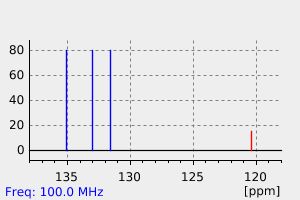四苯基鉮 | 15912-80-8
中文名称
四苯基鉮
中文别名
——
英文名称
Tetraphenylarsonium
英文别名
tetraphenylarsonium ion;tetraphenylarsanium
CAS
15912-80-8
化学式
C24H20As
mdl
——
分子量
383.344
InChiKey
PJMJFVQKDBRMIP-UHFFFAOYSA-N
BEILSTEIN
——
EINECS
——
-
物化性质
-
计算性质
-
ADMET
-
安全信息
-
SDS
-
制备方法与用途
-
上下游信息
-
文献信息
-
表征谱图
-
同类化合物
-
相关功能分类
-
相关结构分类
计算性质
-
辛醇/水分配系数(LogP):3.06
-
重原子数:25
-
可旋转键数:4
-
环数:4.0
-
sp3杂化的碳原子比例:0.0
-
拓扑面积:0
-
氢给体数:0
-
氢受体数:0
SDS
反应信息
-
作为反应物:描述:AMMONIUM TETRATHIOTUNGSTATE 、 四苯基鉮 以 not given 为溶剂, 生成 mono(tetraphenylarsonium) monotetrathiotungstate参考文献:名称:Chandrasekaran, Jayanthi; Ansari, Mohammad A.; Sarkar, Sabyasachi, Inorganic Chemistry, 1988, vol. 27, # 20, p. 3663 - 3665摘要:DOI:
文献信息
-
Multihydrido-complexes of osmium and related complexes作者:P. G. Douglas、B. L. ShawDOI:10.1039/j19700000334日期:——A new route to tetrachloro-complexes of the type trans-[OsCl4L2] from mer-[OsCl3L3](L = tertiary phosphine or tertiary arsine) is described, which involves treatment with chlorine in the presence of light. The tetrachloro-osmium(III) complex trans-[OsCl4(PMe2Ph)2] reacts with tertiary phosphines, tertiary arsines, alkyl phosphites, or alkyl phosphonites (L′) to give [OsCl3(PMe2Ph)2L′]. Reduction of到所述类型的四氯络合物的新路由反式- [OSCL 4大号2 ]从聚体- [OSCL 3大号3 ](L =叔膦或叔胂)中描述,其涉及用在光的存在下氯处理。四氯-(III)配合物反式-[OSCl 4(PMe 2 Ph)2 ]与叔膦,叔a,烷基亚磷酸酯或烷基亚膦酸酯(L')反应,得到[OSCl 3(PMe 2 Ph)2 L ”]。的还原聚体[OSCL - 3大号3或[OSCl 3(PMe 2 Ph) 2 L']或硼氢化钠或氢化铝锂得到[OSH 4 L 3 ]或[OSH 4(PMe 2 Ph) 2 L']型四氢-配合物。反式-[OSCl 4(PMe 2 Ph) 2 ]的类似还原得到[OSH 6(PMe 2 Ph) 2 ]和[OSCl 4(PMe 2 Ph) 2 ] -的混合物。[OSH 4 L 3类型的四氢化物]与氯化氢反应生成fac- [OSCl 3 L 3 ]。四氢化物还与EtOD在苯中缓慢反
-
Electronic properties of thiolate compounds of oxomolybdenum(V) and their tungsten and selenium analogs. Effects of oxygen-17, molybdenum-98, and molybdenum-95 isotope substitution upon ESR spectra作者:Graeme R. Hanson、Andrew A. Brunette、Angus C. McDonell、Keith S. Murray、Anthony G. WeddDOI:10.1021/ja00398a013日期:1981.4The series of crystalline, mononuclear B/sup +/(MO(XR)/sub 4/)/sup -/ and triply bridged binuclear B/sup +/(M/sub 2/O/sub 2/(XR)/sub 6/(OMe))/sup -/(M = Mo, W; X = S, Se; R = aryl; B = quaternary cation) salts have been isolated and the anions (MoO(SR)/sub 4/)/sup -/ (R = Et, CH/sub 2/Ph) stabilized in solution at -60/sup 0/C. The mononuclear anions are intensely colored due to a ligand-to-metal charge-transfer系列结晶、单核 B/sup +/(MO(XR)/sub 4/)/sup -/ 和三桥双核 B/sup +/(M/sub 2/O/sub 2/(XR)/sub 6/(OMe))/sup -/(M = MO, W; X = S, Se; R = 芳基; B = 季阳离子) 盐和阴离子 (MOO(SR)/sub 4/)/ sup -/ (R = Et, CH/sub 2/Ph) 在溶液中稳定在 -60/sup 0/C。由于双核物种中不存在配体到金属的电荷转移跃迁,单核阴离子具有强烈的颜色。(Et/sub 4/N)(MO(SPh)/sub 4/) 的磁化率在 300 到 4.2 K 的范围内显示出居里相关性,钨化合物有微小的偏差。该行为本质上是磁性稀释的 4d/sup 1/ 和 5d/sup 1/ 系统的行为,表现出四方配体场并大大减少了金属上的自旋轨道耦合。双核化合物中强自旋-自旋耦合的存在导致磁矩接近于
-
Highly reduced organometallics XXVII. Synthesis, isolation and characterization of trisodium tricarbonylcobaltate(3 -), and initial studies on its derivative chemistry作者:John E. Ellis、Paul T. Barger、Mark L. Winzenburg、Garry F. WarnockDOI:10.1016/0022-328x(90)85151-n日期:1990.2Reduction of A[Co(CO)4] by three equivalents of A (A = sodium or potassium) in liquid ammonia provides salts containing tricarbonylcobaltate(3 -). A satisfactorily pure sodium compound, Na3[Co(CO)3] is described for the first time. Reactions of A3[Co(CO)3] with two equivalents of Ph3ECl (E = Ge, Sn, Pb) provides 50–70% yields of trans-(Ph3E)2Co(CO)3− which have been isolated as analytically pure Et4N+在液氨中将A [Co(CO)4 ]还原为三当量的A(A =钠或钾)可得到含三羰基钴酸盐(3-)的盐。首次描述了令人满意的纯钠化合物Na 3 [Co(CO)3 ]。A的反应3 [Co(CO)3 ]的Ph的两当量的3 ECL(E =锗,锡,铅)提供了50-70%的收率的反式- (PH 3 E)2的Co(CO)3 - ,其具有分离出分析纯的Et 4 N +盐。K 3 [Co(CO)3的液氨浆料的处理]与三个当量的NH 4在PR的存在氯3或CNR,导致氢气的进化且Co(CO)形成3大号- 。在L = t-BuNC的情况下,制备第一个这样的被异氰酸酯取代的羰基钴(1-)物质,并通过该方法以67%的收率分离。对于形成的Co(CO)一种可能的途径3大号-选自K 3 [Co(CO)3 ]在光类似质子化反应的讨论报道其他carbonylmetallate抗衡三。
-
The reaction of trichlorostannate(II) and trichlorogermanate(II) with boron trifluoride作者:I Wharf、D.F ShriverDOI:10.1016/0022-1902(70)80589-9日期:1970.6Contrary to an earlier report, the interaction of BF3 with SnCl3− or GeCl3− does not lead to the formation of simple complexes such as Cl3SnBF3. The reaction which does occur may be described as Cl− transfer from a weak Lewis acid, MCl2 (M = Sn or Ge), to a stronger Lewis acid, BF3; viz SnCl3− + BF3 = SnCl2 + BF3Cl−.
-
Synthesis of the cluster dianion [Os<sub>11</sub>C(CO)<sub>27</sub>]<sup>2–</sup>by pyrolysis and its reactions with electrophiles; X-ray structure analysis of the mixed-metal derivative [PMePh<sub>3</sub>][Os<sub>11</sub>C(CO)<sub>27</sub>{Cu(NCMe)}]·CH<sub>2</sub>Cl<sub>2</sub>and the hydrido derivative [PMePh<sub>3</sub>][Os<sub>11</sub>C(CO)<sub>27</sub>H]作者:Simon R. Drake、Brian F. G. Johnson、Jack Lewis、William W. J. H. Nelson、Maria D. Vargas、Trushar Adatia、Dario Braga、Kim Henrick、Mary McPartlin、Angelo SironiDOI:10.1039/dt9890001455日期:——The new cluster species [Os11C(CO)27]2–(2) has been identified as one of the products resulting from the pyrolysis of [Os3(CO)12]. It reacts with [Cu(NCMe)4] BF4 to yield the monoanion [Os11C(CO)27Cu(NCMe)}]–(4) and [Os11C(CO)27Cu(NCMe)}2](5). The reaction of (2) with iodine-iodide produces a series of iodo-clusters [Os11C(CO)27I]–(8) and [Os11C(CO)27I2](9) which are converted back into (2) by addition新的簇物种[Os 11 C(CO)27 ] 2–(2)已被确定为[Os 3(CO)12 ]的热解产物之一。它与[Cu(NCMe)4 ] BF 4反应生成单阴离子[Os 11 C(CO)27 Cu(NCMe)}] –(4)和[Os 11 C(CO)27 Cu(NCMe)} 2 ](5)。(2)与碘碘化物的反应产生一系列碘簇[Os 11 C(CO)27 I] –(8)和[Os 11 C(CO)27 I 2 ](9)通过添加卤离子被转换回(2)。不稳定的单阴离子物质[Os 11 C(CO)27 M(PMe 2 Ph)}] – [M = Au(3)或Cu(7)]是由(2)与[M(PMe 2 Ph) )] +和(3)的进一步反应生成[Os 11 C(CO)27 Au(PMe 2 Ph)} 2 ](6)。双阴离子簇(2)与酸反应生成单阴离子[Os 11 C(CO)27 H 2] -(10)和[Os
表征谱图
-
氢谱1HNMR
-
质谱MS
-
碳谱13CNMR
-
红外IR
-
拉曼Raman
-
峰位数据
-
峰位匹配
-
表征信息
同类化合物
(βS)-β-氨基-4-(4-羟基苯氧基)-3,5-二碘苯甲丙醇
(S,S)-邻甲苯基-DIPAMP
(S)-(-)-7'-〔4(S)-(苄基)恶唑-2-基]-7-二(3,5-二-叔丁基苯基)膦基-2,2',3,3'-四氢-1,1-螺二氢茚
(S)-盐酸沙丁胺醇
(S)-3-(叔丁基)-4-(2,6-二甲氧基苯基)-2,3-二氢苯并[d][1,3]氧磷杂环戊二烯
(S)-2,2'-双[双(3,5-三氟甲基苯基)膦基]-4,4',6,6'-四甲氧基联苯
(S)-1-[3,5-双(三氟甲基)苯基]-3-[1-(二甲基氨基)-3-甲基丁烷-2-基]硫脲
(R)富马酸托特罗定
(R)-(-)-盐酸尼古地平
(R)-(-)-4,12-双(二苯基膦基)[2.2]对环芳烷(1,5环辛二烯)铑(I)四氟硼酸盐
(R)-(+)-7-双(3,5-二叔丁基苯基)膦基7''-[((6-甲基吡啶-2-基甲基)氨基]-2,2'',3,3''-四氢-1,1''-螺双茚满
(R)-(+)-7-双(3,5-二叔丁基苯基)膦基7''-[(4-叔丁基吡啶-2-基甲基)氨基]-2,2'',3,3''-四氢-1,1''-螺双茚满
(R)-(+)-7-双(3,5-二叔丁基苯基)膦基7''-[(3-甲基吡啶-2-基甲基)氨基]-2,2'',3,3''-四氢-1,1''-螺双茚满
(R)-(+)-4,7-双(3,5-二-叔丁基苯基)膦基-7“-[(吡啶-2-基甲基)氨基]-2,2”,3,3'-四氢1,1'-螺二茚满
(R)-3-(叔丁基)-4-(2,6-二苯氧基苯基)-2,3-二氢苯并[d][1,3]氧杂磷杂环戊烯
(R)-2-[((二苯基膦基)甲基]吡咯烷
(R)-1-[3,5-双(三氟甲基)苯基]-3-[1-(二甲基氨基)-3-甲基丁烷-2-基]硫脲
(N-(4-甲氧基苯基)-N-甲基-3-(1-哌啶基)丙-2-烯酰胺)
(5-溴-2-羟基苯基)-4-氯苯甲酮
(5-溴-2-氯苯基)(4-羟基苯基)甲酮
(5-氧代-3-苯基-2,5-二氢-1,2,3,4-oxatriazol-3-鎓)
(4S,5R)-4-甲基-5-苯基-1,2,3-氧代噻唑烷-2,2-二氧化物-3-羧酸叔丁酯
(4S,4''S)-2,2''-亚环戊基双[4,5-二氢-4-(苯甲基)恶唑]
(4-溴苯基)-[2-氟-4-[6-[甲基(丙-2-烯基)氨基]己氧基]苯基]甲酮
(4-丁氧基苯甲基)三苯基溴化磷
(3aR,8aR)-(-)-4,4,8,8-四(3,5-二甲基苯基)四氢-2,2-二甲基-6-苯基-1,3-二氧戊环[4,5-e]二恶唑磷
(3aR,6aS)-5-氧代六氢环戊基[c]吡咯-2(1H)-羧酸酯
(2Z)-3-[[(4-氯苯基)氨基]-2-氰基丙烯酸乙酯
(2S,3S,5S)-5-(叔丁氧基甲酰氨基)-2-(N-5-噻唑基-甲氧羰基)氨基-1,6-二苯基-3-羟基己烷
(2S,2''S,3S,3''S)-3,3''-二叔丁基-4,4''-双(2,6-二甲氧基苯基)-2,2'',3,3''-四氢-2,2''-联苯并[d][1,3]氧杂磷杂戊环
(2S)-(-)-2-{[[[[3,5-双(氟代甲基)苯基]氨基]硫代甲基]氨基}-N-(二苯基甲基)-N,3,3-三甲基丁酰胺
(2S)-2-[[[[[((1S,2S)-2-氨基环己基]氨基]硫代甲基]氨基]-N-(二苯甲基)-N,3,3-三甲基丁酰胺
(2S)-2-[[[[[[((1R,2R)-2-氨基环己基]氨基]硫代甲基]氨基]-N-(二苯甲基)-N,3,3-三甲基丁酰胺
(2-硝基苯基)磷酸三酰胺
(2,6-二氯苯基)乙酰氯
(2,3-二甲氧基-5-甲基苯基)硼酸
(1S,2S,3S,5S)-5-叠氮基-3-(苯基甲氧基)-2-[(苯基甲氧基)甲基]环戊醇
(1S,2S,3R,5R)-2-(苄氧基)甲基-6-氧杂双环[3.1.0]己-3-醇
(1-(4-氟苯基)环丙基)甲胺盐酸盐
(1-(3-溴苯基)环丁基)甲胺盐酸盐
(1-(2-氯苯基)环丁基)甲胺盐酸盐
(1-(2-氟苯基)环丙基)甲胺盐酸盐
(1-(2,6-二氟苯基)环丙基)甲胺盐酸盐
(-)-去甲基西布曲明
龙蒿油
龙胆酸钠
龙胆酸叔丁酯
龙胆酸
龙胆紫-d6
龙胆紫







